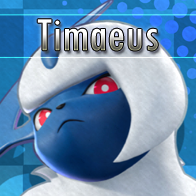Leaderboard
Popular Content
Showing content with the highest reputation on 05/30/2017 in all areas
-
Tapping into what Gario said, contrast and also song structure. If you're able to transition from an intro to a verse, you are probably already subconsciously doing a transition. Doing the same from verse to chorus isn't much different. You need the piece of music to drive you along to the story you want it to tell, and contrast and structure are great ways of helping you tell the story. The reason I bring up song structure is that it can be helpful to create these transitions. If you have a verse, chances are you want to have a kind of chorus or a prechorus or a bridge after that. Knowing what you want to do next can help you think of what kind of transitions you would do. A chorus typically has a bigger sound, so you probably are going to add some extra instruments (which you may already start to bring in at the last part of your verse). A bridge is usually quite different from the rest of your song, so you might go half time, drop a lot of instruments and use a pad and swap the lead instrument around. A pre chorus is usually pretty short, so you know you have 2-4 bars to do something and make it count. That's not to say you need to cook up a song structure up front, but it might help. My tracks typically grow organically and I would find it hard to label something as a verse of chorus, but subconsciously I do apply the concepts highlighted above. A variation of that theme is a trick I stole from zircon... whenever you have finished a section of a song, think about whether you feel it needs to become more intense or less intense. This also depends on the story you try to tell; for a calm song I'd probably add a more intense section after a few calmer parts, for contrast, and vice versa. Of course 'more intense' and 'less intense' also imply things you can do to make them more or less intense. More intense might be making your bassline go from eights to sixteens while you have the drummer hit the ride cymbal and maybe play around with some sus2/sus4 chord variations in a different rhythm, less intense might be long sustained notes and a slower melodic line with more space between the notes. Lastly I would say that the genre you pick also can be a great help. How to other tracks in that genre that you like transition, and is that something worth stealing/copying? A stutter works well for EDM, for rock you might have a reverse crash and for jazz you might end up with a drum break. Hope it helps somewhat, despite not having any theory pointers for you. I just do stuff, I leave the theory to others so they can explain to me what I did2 points
-
Super general rule of thumb: Contrast. Contrast is everything in making an effective transition between parts. The more different the sections, the more likely it'll be considered a new section to the listener's mind. if you're having trouble making something sound like a transition, drop out more elements, change more items until things sound very different from what came prior (yet has enough motivic elements to keep the track sounding relevant to your arrangement). It's a tricky balance, but contrast is the one big item that makes one section sound different from another. A really cheap trick? At the end of one section, drop everything out, then have the next section come in at full strength again. There's really no greater amount of contrast than from going from nothing to everything. Don't overuse it or else the track sounds repetitive, but it's a nifty tool to have under your belt. You probably know this intuitively, since you use it in your latest posted track (yout Lemmings remix, at 3:15), but perhaps hearing it spelled out can help you understand how to use it in the future, as well. There's a whole study on this particular element of music theory, called Temporal Gestalt Perception (or musical segmentation). It's some heavy reading, but if you get through it there's some useful insight on how to parse music into defineable segments. For the super technical among us the theory has issues in it's applicability (since there's no way to properly weigh how much an individual count things like timbre, dynamics and harmony as 'different enough'), but the concept is pretty sound: we hear contrast as something that separates the music into sections. Hope that helps!2 points
-

Darkish Dance Beat
InfernoZN reacted to timaeus222 for a topic
No problem! Yeah, a bigger keyboard would help a lot. I have a 37-key keyboard, which is good enough for me, but if I had room I would have gotten a 49-key. It's nice to have room to play open chords and to play with two hands, and my keyboard has been a great resource for coming up with ideas.1 point -
I'm a small-time Let's Player though I haven't released anything new in a couple months or so. So far I've mostly done classic RPGs like the SNES Final Fantasy games and Chrono Trigger, though I've also done the early Zeldas and some 2D platformers. I take a walkthrough approach to the RPGs, explaining the mechanics of the system and any battle strategies I know of for specific situations, etc. I also usually read dialogue and give the characters voices, admittedly to varying degrees of success, though I have gotten positive comments for it from time to time. I have some playlists linked in my signature but if anyone's interested in checking out my channel, the link is right here: https://www.youtube.com/channel/UC1Ek_bkrHSNhwS96nTVlX5Q1 point
-
Alrighty! I'll split this into a couple sections: first, video production tips! Audio quality is super important. Video quality is important too, of course: high resolution and framerate while recording will go a long way, as will nice-looking visual elements like overlays and end slates. But audio can make or break your LP channel. If your voice is hard to hear or your mic makes you unpleasant to listen to, a lot of people won't stick around. LPers kinda have to be low-level audiophiles. If you look at the most famous LPers out there, a lot of them have some impressive recording spaces for this very reason. If your hearing makes this difficult, see if you can get a hand from a friend who has an ear for audio! And always prioritize your voice over the in-game audio when editing/mixing in post! Being able to hear the game is important, but if viewers can't hear and understand you, then the whole experience falls apart. Practice being entertaining! Being a Let's Player is deceptively difficult, way more than most people assume. Talking and constantly being entertaining while also concentrating on the game you're playing is super hard. But being charismatic is maybe the single most important key to Let's Play success. Let's Play channels run on personality. Your viewers could easily play any of these games themselves, or watch any other YouTuber play them, but they came to your channel because they want to feel like they're hanging out with you. Being a Let's Player often means being an entertainer, even if you're not forcing a goofy or screechy persona. So keep practicing! Try to engage the facecam when you can. Don't go silent for too long unless it's appropriate for the moment in the game. Heck, take an improv class if you really want to pursue this stuff hardcore. This is a performance skill just like acting, so keep working that muscle. Analyze other Let's Players for ideas! Pick a few channels that you really like and want to emulate, and then carefully study their work. What sort of visual elements do they add? Are their videos long or short? Do they edit their videos to trim out the boring parts? How do they start each episode? What sort of info do they put at the end? Learn from those who are already succeeding in this scene. If you don't know how to do a thing they're doing, that's a perfect opportunity to start researching! The more stuff you learn how to do, the better you can make your own videos. Ok now for some general YouTube tips: Make your thumbnails eye-catching. You want them to entice. This is why you see so many channels using bright colors, starburst background patterns and faces featured prominently; it's the kind of stuff that catches the eye. Of course, also try to make the thumbnail give an accurate idea of what the video contains so people who are looking for your kind of content recognize that your video is what they were looking for. Featuring your own face isn't a bad idea, and featuring art/logos from the game you're playing is probably a good idea too. There's no secret to success here, just keep experimenting and improving your designs as you go. The more clicks you can draw, the more your channel will grow, so this is a pretty important component of each video's success. Release videos as regularly as possible. Daily, if you can. It allows you to become a daily part of your subscribers' lives, part of their routine. It's a great way to build and maintain a regular audience. Try playing new or popular releases now and then. When a game first comes out, lots of people are going to be eager to see that game played on YouTube and Twitch. Hopping on that train can be a great way to draw in some new viewers. Of course, you don't have to do that all the time. Again, personality is the real key to success; your regular viewers will likely enjoy seeing you play anything. But if you only play older games that you never got around to in your Steam queue, you may have a hard time building a large audience as quickly. There's no single shortcut to channel growth. Success on YouTube is equal parts luck and dedication. Release videos regularly, strive to make your content more and more entertaining, work to become a more charismatic personality. Doing cross-overs with other popular YouTubers can help, but it won't guarantee a fast-track to success. Sub 4 Subs almost certainly won't fast track you either. Your best bet is to just be dedicated, strive for quality and do what you can to stand out. And play to your strengths. Are you funny? Charismatic? Maybe you're an especially skilled player? Or maybe you have something else unique to bring to the table? The more you can stand out in a positive way as a personality, the better. I think my single biggest tip would be this: if being a professional YouTube personality is your goal, throw yourself into that shit. Trying to become a famous YouTube personality these days is like trying to be a famous rock star or famous hollywood actor. It's harder than ever: the scene is flooded now and extremely competitive. Success is far from guaranteed. All the famous streamers and Let's Players you see out there making a living doing this? They work their asses off. Easy as this career looks from the outside, it takes an enormous amount of time and dedication. So if you want that goal, commit yourself to it fully! Do everything you can to be the absolute best you can be. Study the platform, study your peers, watch your channel analytics and see what you can learn from the patterns. Try to make content that you'd want to watch. If you keep making great videos and releasing them consistently, the audience will slowly find you and the snowball will start rolling. Good luck!1 point
-

Darkish Dance Beat
InfernoZN reacted to timaeus222 for a topic
Hey man, here are some of my main thoughts on this: The main squelchy synth doesn't really change its pattern much. It keeps the same rhythm throughout for the most part until, for instance, 1:44. It could have more variation in its rhythm (and consequently what's going on around it can as well). The delayed lead that came in at 0:17 is a little pitchy at 0:32. It's as if you slightly moved the pitch wheel and too slowly, which makes the sound appear as if it were itself "nauseous". (Minor details like that are pretty important in the big picture if they happen several times.) The lead sequence at 1:08 - 1:25 was a bit noodly/rambly/random in melodic contour. I liked the break at 1:44, but the rising distorted lead (which is too piercing in the upper treble; try a mild low pass) overstayed its welcome for me since it mostly sustains and wiggles a bit. I thought it was going to be a riser to go somewhere, but instead it just led to a complete stop... that starts up again after too long of a silent gap, IMO. Your vocals are pretty good though.1 point -

OCR Cribs (the "Post Pics of your Studio Area" thread!)
Necrox reacted to Chernabogue for a topic
^Still better than mine, which is literally just my PC.1 point -

Music Programs Compatible with FL?
InfernoZN reacted to timaeus222 for a topic
Most if not all free VSTs work in FL... and if you don't believe me, why don't you try them out? They ARE free, right?1 point -

What genre of music fits each style of Sonic best?
Chernabogue reacted to AngelCityOutlaw for a topic
Death metal1 point -

Music Programs Compatible with FL?
InfernoZN reacted to AngelCityOutlaw for a topic
FL Studio itself can be loaded as a VST in other hosts A feature I'm not sure I fully understand the purpose of.1 point




